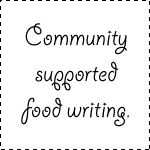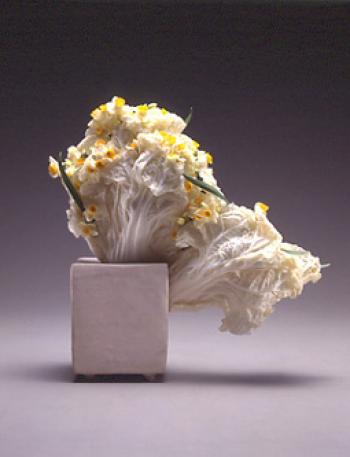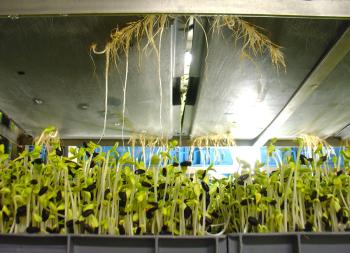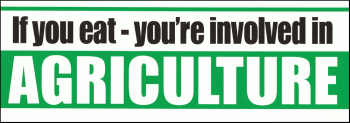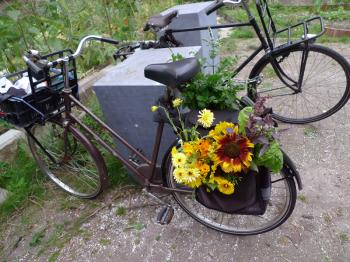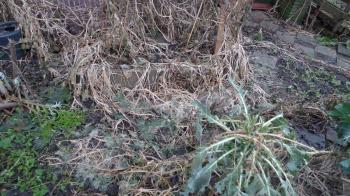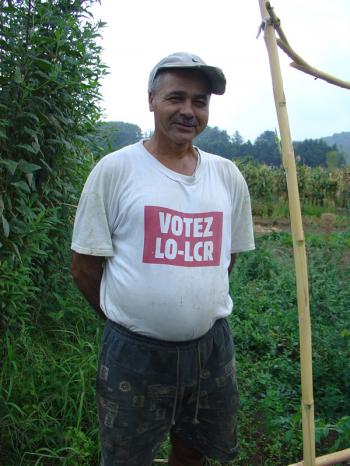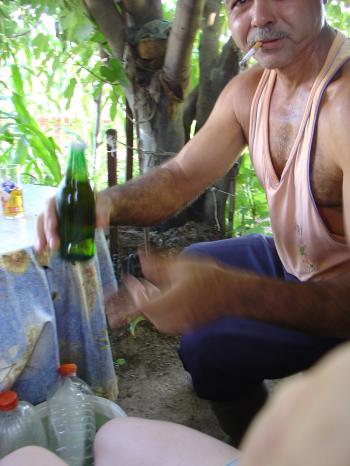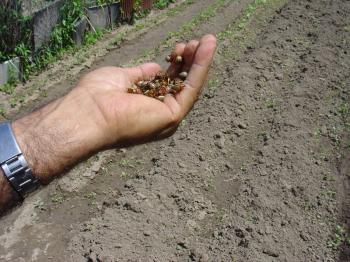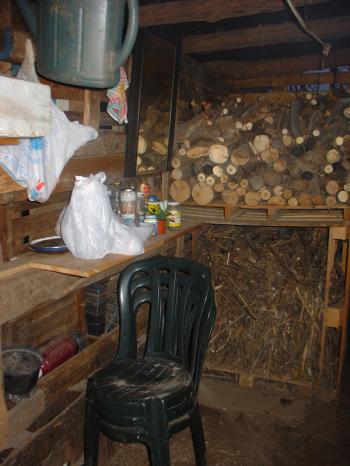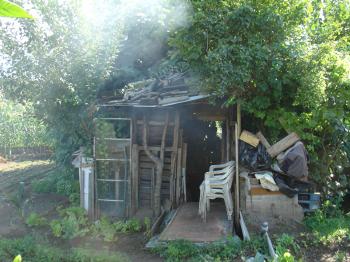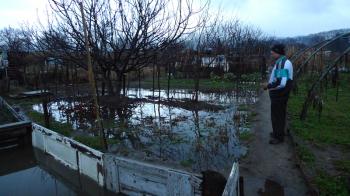And what will fuel the landscape of the future?
March 6, 2009
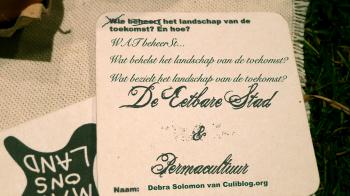
The answers are: the Edible City & Permaculture
This week I attended a dinner at the Netherlands Architecture Institute (NAi), smack dab in the exhibition called MAAK ONS LAND,
which literally translated means, MAKE OUR LAND
but which was translated by the NAi as the hopeful, SHAPE OUR COUNTRY,
but also implying the poetic, MAKE US SOME LAND
(because we don’t have enough for some crazy reason and we have a heritage of pulling it out of our thumbs) or
(HERE’S HOW WE COULD) DEVELOP OUR LAND, or beseechingly with melting eyebrows,
GIVE US SOME LAND, SOME ELBOW ROOM TO FULFILL OUR HEART’S DESIRE!
The title MAAK ONS LAND is ambiguous about whether it’s a call for action or an order from the masses directed at our planners. Non-Dutch people should note that We-Dutch have a high (urban) planner to regular person ratio, to the point that there’s barely a distinction between the two. Land use planning can have a timeline of up to 200 years (I joke not), with a shocking lack of chaos involved, or for that matter even tolerated.
This is an interpretation from the brain of an immigrant to merely explain the exhibition title. An exhibition which I didn’t see, because I (along with 50 other illustrious professionals) was invited to a dinner amidst MAAK ONS LAND and which was titled GREEN. Also ambiguous, but the alternative, FUTURE LAND USE PLANNING AND ITS REQUISITE INFRASTRUCTURE sounds about as sexy as an enema.
GREEN it is.
GIMME SOME LAND.
SLAP ME FIVE.
WHO WILL BE IN CHARGE OF THE LANDSCAPE OF THE FUTURE, AND HOW?
After changing the question from
IN CHARGE OF
to
RESPONSIBLE FOR
and saving the AND HOW part for later,
the discussion became rich and lively. Considering the wide-range of disciplines (architects, artists, designers, various sorts of planners, horticultralists, land managers, government ministers etc…) it was a miracle that we often got our noses pointing in the direction of land use and food.
Without reporting on the discussion, because you will certainly be able to read between the lines, here is my conclusion: We need a COMMON LANGUAGE to discuss future land use and planning that accesses current levels of knowledge from the diverse disciplines involved.
This conclusion keeps cropping up whilst keeping mixed company. Because the archi/planner/policy maker bro’s like their statistics and NEED their statistics to make/justify decisions, we need numbers that describe different forms of land use, agricultural output and food flow impact. Current statistics are INsufficient to address this subject (see below). (Jago vB., Jan H., Menno S., let’s talk about this.)
- 1. We need to understand in much greater detail what the presence of different kinds of food in our diets means for our landscape - in a geo-political sense, but also in terms of needed infrastructure and planning locally and regionally. A small shift in diet could mean a large change in land use. There is a lack of imagination about how a food-related infrastructure that would impact our cities to such a tremendous degree (already does) could be used, nay SHARED equitably.
2. We need to have a greater understanding about what the presence of food in our cities means and does in terms of FLOW and how food flow can be used more efficiently, also in terms of health and income generation for local populations. Again, small changes and benefits concerning i.e. the presence of WHOLE FOODS could have an enormous and beneficial impact. Experiments exist, let’s get some numbers together for the guys that loves them up some numbers!
3. There is a LACK of knowledge about the various forms of agriculture. This needs to change forthwith. Prevailing misconceptions amongst many architects and planners include an assumption of traditional (high-tech) rural agriculture, monoculture, export culture, business models based upon farm subsidies and current levels of oil-use, and the continued production of industrialised foods and food products/components (globally) requiring oil-rich distribution methods. We are not discussing all of our viable options or the conditions that we will likely encounter in the future.
4. There is a LACK of knowledge about permaculture, let alone reliable statistics concerning its level of productivity as an agricultural form on the (urban) landscape. We need to share knowledge and develop statistics about RESILIENT FORMS of agriculture in the relevant planning forums.
5. There is currently NO holisitic (planning) visioning for agriculture (primarily urban agriculture) which is integrated into Western European urban culture. (Actually there is… but I’ll tell you about that later.)
As someone who believes that it is in our interest in our roles as citizens to invest in our own communities and our own economies - that investment does NOT include filling urban spaces with TOWER BLOCK agriculture FOR EXPORT USE / OR HORTICULTURE. It is not that I oppoose the high-rise or the intensive programming (because I am actually positive about certain forms), but that many/most of these projects are intended to benefit global agro-business and horticulture, and not intended to feed us. Also, the architecture supporting these intensive forms of proposed vertical (urban) agriculture needs to be RESILIENT in terms of crop and fuel use.
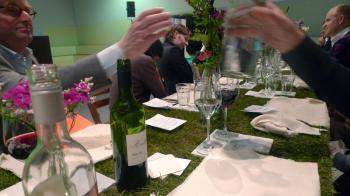
Men sharing water, not necessarily opinions
Even in the most progressive professional discussion about urban agriculture we need to make sure that we are on the same page before we can even speak of PLANNING. We need a common language.
So… how did I answer the question that the NAi asks its visitors? First of all I changed the question to … an even better question: WHAT WILL FUEL THE LANDSCAPE OF THE FUTURE?
And my answer is and remains: the EDIBLE CITY… a pre-cursor to MAAK ONS LAND.
debra at 19:42 | Comments (3) | post to del.icio.us
In Memoriam Sidi El Gouche
February 27, 2009
Last week I received the very sad news that my dear friend, Sidi El Gouche, my Occitanian kitchen garden neighbour, has died. It has taken me a long time to get to the point that I could even write this memorial to him because I am just devastated that he is gone. He was a passionate and capable gardener, the deputé of our gardens, and to me, a cherished friend.
Sidi El Gouche was
a warm and generous man,
a bestower of fig tree shade,
a distributer of local talk, beer and cigarettes,
a keeper of an open house.
An indoor/outdoor bbq expert,
a hearty lunchtime chef in the dead of winter,
a summertime host of countless happy hours,
A sprinkler of sea salt on cherry tomatoes,
a bbq’er of sardines, of chickens and merguez,
a mouse murderer,
afraid of snakes.
A planter of peach trees and apricots,
a fig growing, fig sharing man,
a giver of fig trees and sweet figs piled high on plates to celebrate, anything.
A coriander specialist,
a ruthless weeder,
a collector and then crusher of bugs,
a harvester in every season except for winter, which he used for preparing the garden for spring,
an exemplary gardener, giving new meaning to the term, French Intensive.
C’est le moment.
C’est le moment.
A climber of trees,
a chopper of wood and sticks for the bbq and staking up plants,
an overseeer of fires,
a sharpener of knives,
a fixer of my hoes and rakes and shovels,
a mighty swift digger of ditches,
an insightful consultant and irrigation expert,
a defender of our right to water, with the right amount of water pressure to fill our thirsty gardens.
A diplomat between the rural French, the Berber and the Northern Import communities, holding frequent audience between factions in his cabane,
a somewhat traditional Muslim (Allah is Lucky) but,
a feminist in practice, especially concerning his own daughters,
a man who could really tell a story, but then ten times in 3 languages.

An eater of baby grandson hands,
A grower of crispy lettuces in the shade,
a producer of sweet Cevenol onions and potatoes,
an agriculturalist if you will, he fed his 9 kids and many grandkids from his garden.
A really liberal user of chemical fertilizers,
a strewer of little blue pills on the land, but also,
an inadvertent defender of different ways of gardening, even though he called my mustard cover crop, ‘Mayonnaise’.
A smile-wearing, sparkly-eyed, warm-hearted, open-armed giver of bear hugs Hallo Hallo Hallo! after many months of absence,
A feeler of biceps, inspector of callouses, and generous with compliments in the face of man-like feats of strength and stamina,
a man who understood the value of a good cup of mint tea at just the right moment,
An emotional giver of bear hugs Goodbye for now for months, Come back soon and, Insh’Allah till the next time, with promises to water my garden till I get back.
Sidi El Gouche, I had been planning on a long lifetime of gardening, with you always there, gardening with me.
I really, really miss you.
debra at 12:49 | Comments (2) | post to del.icio.us
A happy new year
for the fruit trees
February 10, 2009
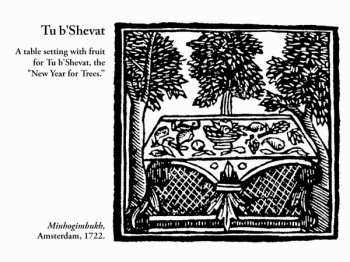
Woodcut for the Jewish arbor day Tu b’Shvat, from the Minhogimbukh Amsterdam 1722, recently adapted by Scott-Martin Kosofsky, image used entirely without permission.
There’s nothing like a religious calendar sporting multiple ‘new years’ to remind us that we were once deeply connected to our food systems. Agrarian celebrations lace the Jewish calendar commemorating inventory and tithing, sorting and sowing, fasting, harvesting, slaughtering, and all manner of specialized and neurotic food preservation. Ancestors, be happy, you left an indelible mark.
Tu b’Shvat is not a biblical holiday but comes from the Mishnah, the Jewish book of case-studies, aka the ‘Oral Torah’. At that time (about 2000 years ago) a tithe of fruit and vegetables used to be paid to landlords as a form of taxation. This was the time of year when the fruit tree inventory took place and the age of trees was determined. Somehow the 16th century Kabbalists of Tsfat transformed this into a festival by accompanying their prayers with wine & fruit, and the Jewish custom of celebrating paying taxes in fresh produce was born. What, how do you pay yours?
By now Tu b’Shvat is about tree-planting and other big fans of diaspora like me will appreciate the ‘bloom where you are planted’ angle on this holiday. I’m thinking that a good Tu b’Shvat resolution for those of us lucky enough to have fruit trees would be to make sure that the fruit of our trees doesn’t go to waste. If you can not eat and preserve it all by yourself, there are organizations that will help you do so, either by turning it into jams, chutneys, leather, and pies, or by donating the fruit to folks that don’t get their recommended 2 cups of fresh per day. I’ve listed some of these orgs in the notes below this entry. And if you yourself want to engage in some ad-hoc leather and jam, in L.A. the artist collective Fallen Fruit has made maps of the city’s fruit trees that can be harvested either voluntarily or less so.
My New Year for the Trees resolution will be to make dang sure to design fruit-bearing FEMALE trees into the public space occupied by my urban projects. I hadn’t really thought about the fact that landscape architects the world over were primarily planting MALE trees in our cities until I read Thomas Leo Ogren’s essay in Actions: What You Can Do With the City. He writes, Male trees grow no fruit, seeds, or seed pods, and thus are considered “litter-free.” From a caretaking point of view they are “low maintenance.” The human health impact is that our cities are filled with highly allergenic pollen producing, sperm-spewing males. Considering that allergies now affect some 40% of all urbanites, the obvious solution to this public health threat, and one whose spinoff could create jobs and micro-economies, is not just to blame the males but to plan and plant fruit-producing female trees.
If Channukah is the Jewish holiday of Peak Oil, then surely Tu B’Shvat is the Jewish holiday of urban agriculture! In the coming period of New Austerity, I predict that Tu b’Shvat will reach unprecedented secular popularity, resonating even more than… Purim! Remember, you read it here first.
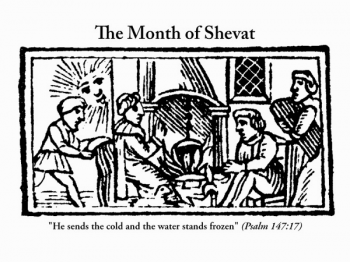
Woodcut for the month of Shvat, from the 1722 Amsterdam edition of the Book of Customs, now adapted by Scott-Martin Kosofsky, image used without permission
- Tu b’Shvat according to the hive brain of Wikipedia. If nothing else, a good starting point before spiraling out of control.
Scott-Martin Kosofsky’s newly adapted Book of Customs can be purchased here, here and here.
Village Harvest is a nonprofit suburban harvesting cooperative in Santa Clara Valley, California, which brings together neighbors and community organizations to provide food for the hungry, preserve our heritage and skills, and promote sustainable use of urban resources. But you can read about other organizations here and you can see a slideshow about urban gleaning here.
Artist collective Fallen Fruit were giving fruit trees away this last weekend, sorry I didn’t know about this earlier. Fallen Fruit maintain maps of urban fruit trees ripe and ready for picking in the LA area.
Want to take a certified course in Permaculture Design?
Here’s a list - for France anyway.Introductory essays by the editors Mirko Zardini and Giovanna Borasi provide historical perspective and establish the curatorial framework for the exhibition and publication. Original essays are contributed by Jochen Becker, Vikram Bhatt, Katrin Bohn, Brendan M. Brogan, Coloco, Henk Döll, Fergus the Forager, Omar Freilla, George J. Grella Jr., Fritz Haeg, Tali Hatuka, Dan Hill, Sarah Hill, Ocean Howell, Hans Ibelings, Momoyo Kaijima, David Ker Thomson, Zoe Laughlin, Sonia Lavadinho, Nina-Marie Lister, Alejandra López, Thomas Leo Ogren, Emily Rauhala, Richard Reynolds, Debra Solomon, Yoshiharu Tsukamoto, Jeroen van Nieuwenhuizen, and Andre Viljoen.
Co-published by Canadian Centre for Architecture, Montréal, and SUN, Amsterdam, the catalogue is designed by Novak, Amsterdam. The 240-page, soft-cover book includes 70 colour and black and white illustrations, and features a folded poster as cover wrap. The volume is available as of 1 December 2008 at the CCA Bookstore in English and French editions for $42.95 CAD/USD ISBN: 978-0-920785-82-9.
debra at 15:58 | Comments (0) | post to del.icio.us
